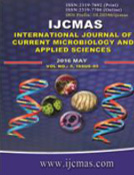


 National Academy of Agricultural Sciences (NAAS)
National Academy of Agricultural Sciences (NAAS)

|
PRINT ISSN : 2319-7692
Online ISSN : 2319-7706 Issues : 12 per year Publisher : Excellent Publishers Email : editorijcmas@gmail.com / submit@ijcmas.com Editor-in-chief: Dr.M.Prakash Index Copernicus ICV 2018: 95.39 NAAS RATING 2020: 5.38 |
In western Sudan including North Darfur; soil productivity is very low, where desertification results from over population in an ecologically vulnerable zone at the margins of the Sahara. In 1970-1973 drought hit this area and aggravated the situation, and its impact is still felt, not only in this area but also in Sudan as a whole (Ibrahim, 1978). The area is characterised by sand dune belts extending south north to join at 16° N the zone of active dune formation and it extend southwards to reach latitude 10° N. Desertification in the same area has progressed around jebel Marra. The study indicated that the northern rocky lands, hills and mountains, dune lands and sandy pediplains are not suitable for arable farming and have poor carrying capacity for grazing. The pediplains, the basins and the erosional plains are not suitable for rainfed farming but conditionally suitable for irrigated farming with poor carrying capacity for grazing. UmmBayada basin lands are marginally to moderately suitable for rainfed farming and are moderately to highly suitable for irrigated farming. The carrying capacity for grazing is fair along the basin. Land degradation due to desertification is the main limitation for development and management of land resources. Although the area has substantial opportunities for agricultural development (mainly rangeland, forestry) nevertheless somealternative land uses should be considered benefitting from the proximity of the area to the state capital and main rural towns.
 |
 |
 |
 |
 |